Battle of Gaugamela › The Ancient Synagogue in Israel & the Diaspora » Origins and History
Articles and Definitions › Contents
- Battle of Gaugamela › Ancient History
- The Ancient Synagogue in Israel & the Diaspora › Antique Origins
Ancient civilizations › Historical places, and their characters
Battle of Gaugamela › Ancient History
Definition and Origins
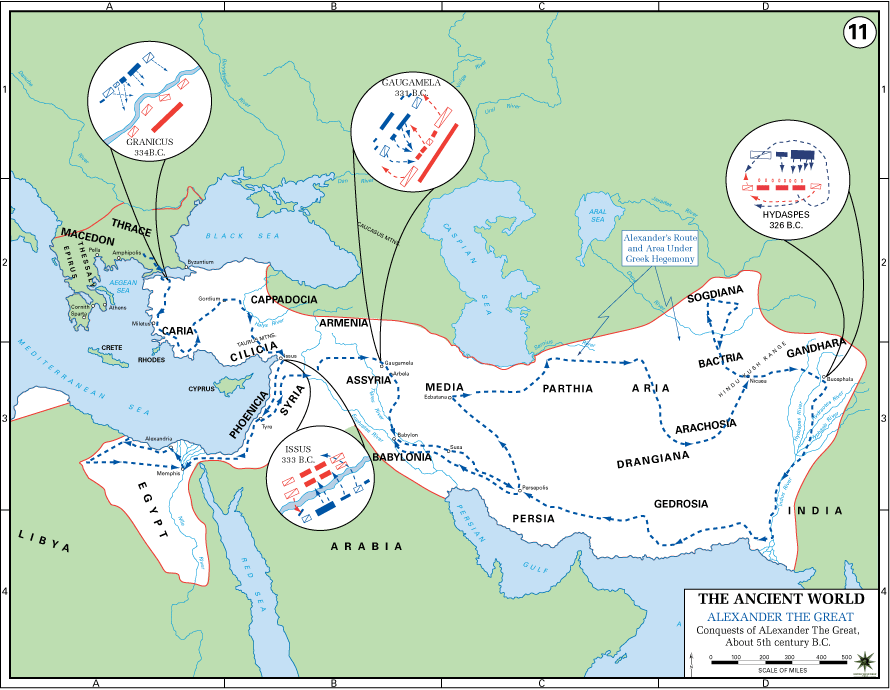
The Battle of Gaugamela (1st October 331 BCE, also known as the Battle of Arbela ) was the final meeting between Alexander the Great of Macedon and King Darius III of Persia. After this victory, Alexander was, without question, the King of all Asia.
Gaugamela (means "The Camel's House") was a village on the banks of the river Bumodus. The site of the battle is thought to be Tel Gomel (Hebrew - "Camels Mount") in northern Iraq.
Following the assassination of Phillip II, his father, in 336 BCE, Alexander and his army left their home of Macedonia for the last time and set out on a goal of conquering all of Persia. After crossing the Hellespont, Alexander travelled northward where he met and defeated the Persians under the leadership of the Greek mercenary Memnon at the Battle of River Granicus. As in future meetings with Alexander, Darius and his generals continually underestimated the abilities of the young Alexander. He was considered by many, even those in Greece, to be nothing more than an upstart.
From River Granicus Alexander moved southward along the coast of Asia Minor to Halicarnassus where he defeated Memnon for the second time. Finally, after waiting for over a year, Alexander and his forces met Darius at Issus in November of 333 BCE where, again, the Persians suffered defeat. Even more embarrassing for Darius was that Alexander captured his family -- his mother, wife and daughters. Wishing to avoid further conflict (and hoping to regain his family), Darius offered Alexander half of his kingdom and even his daughter's hand in marriage; however, Alexander rejected the offer by simply saying there could never be two suns -- it would upset world order. Alexander also challenged the Persian king to face him again in battle.
AFTER LAYING OUT PLANS FOR THE FUTURE CITY OF ALEXANDRIA & VISITING THE TEMPLE AT SIWA, ALEXANDER PREPARED FOR HIS NEXT ENGAGEMENT WITH DARIUS.
From Issus Alexander moved along the Mediterranean coast, capturing the island city of Tyre in a seven-month siege. As he travelled southward, he was welcomed in both Jerusalem and Egypt, for they had felt the wrath of the Persian army and the pangs of religious oppression. After laying out the plans for the future city of Alexandria and visiting the temple at Siwa, Alexander prepared for his next engagement with Darius.
Alexander had planned to march straight to Babylon, but when he learned of Darius' presence at Gaugamela, he turned northward to meet the waiting Persian king. He realized a victory at Gaugamela meant all of Persia -- Babylon, Persepolis, and Susa -- would be his.
Darius, however, had learned his lesson at the Issus and had carefully chosen Gaugamela for his next, and hopefully last, battle against Alexander. This time his army was quite different, having brought together men from all over his empire, even Indian mercenaries -- estimates of his army vary from 50,000 to 100,000 to almost a million. Along with fifteen elephants (although they were never used), he had two-hundred scythed chariots. He fashioned longer swords and lances as well as adding more cavalry. The terrain of Gaugamela was also significant -- it was much wider so he could make use of his chariots and deploy his cavalry more effectively -- something that had been impossible at Issus. He had the ground leveled, placing obstacles and traps to impede the advances of Alexander's forces. To Darius it appeared the size of his army and the terrain gave him a significant advantage.
Alexander made camp several miles from Darius; his men (estimated at 40,000) would only take their weapons to do battle, nothing else. After assembling a small scouting party, Alexander looked down from a hill, unobserved by Darius, accessing the king's preparation. Luckily, while on the scouting trip, he came upon an advance party sent out by Darius. While some of the party fled, several others were captured and more than willingly told of Darius' numbers and the presence of the traps and obstacles on the field.
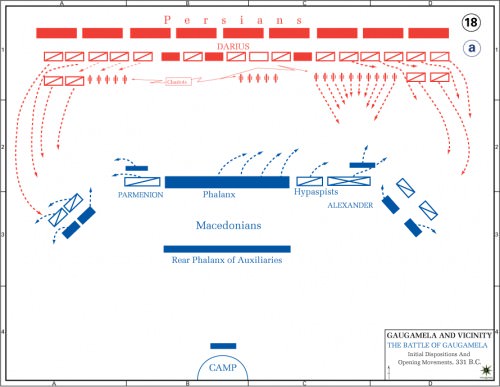
Map of the Battle of Gaugamela - Setup
The night before battle Alexander held a council of his generals; Parmenio, the commander of Alexander's left flank, suggested that the large size of Darius's forces called for them to attack at night; however, Alexander disagreed. The historian Arrian made mention of this episode in his History of Alexander :
It is said that Parmenio came to him in his tent and urged him to make a night attack on the Persians, saying that thus he would fall upon them unprepared and in a state of confusion … but the reply which he made to him … was that it would mean to steal a victory …
Later, as Alexander addressed his men, he spoke of the forthcoming battle, reassuring the typically superstitious Macedonians that an earlier eclipse of the moon was a sign of victory.
On the day of the battle Alexander is said to have overslept. As he had done previously, he made sure his men were well-fed and well-rested. Darius' men, on the other hand, had been awake all night fearing a night attack that never came. As Alexander looked across the battlefield towards the Persians, Alexander called out individual soldiers by name, speaking of their bravery in other battles and asking them to fight again for Macedonia. As he spoke an eagle (a favourite animal of Zeus ) flew overhead and towards Darius. To Alexander this was another omen of victory.
As in every other battle, Alexander and his companion cavalry took position on the right flank while Parmenio, as usual, held the left flank. Stationed in the middle were the well-trained Macedonian phalanx with more light infantry and archers on either side. Alexander also did something different; he chose to place infantry at angles on the ends of both the right and left flanks, to protect against a possible flanking maneuver by the Persians. He also placed additional Greek infantry to the rear of the center.
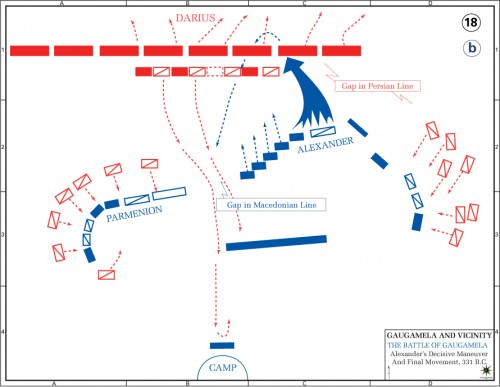
Map of the Battle of Gaugamela - Alexander's Attack
As the battle began, Alexander and his Companions immediately moved to the right at an oblique angle. Following Darius's orders, the Persians, under the leadership of Bessus, moved to their left, countering Alexander in an attempt to outflank him.As the Persians moved further and further to their left and into terrain that had not been cleared, an opening or gap was created. According to some historians, this entire move by Alexander had been a feint. Seeing the opening, Alexander formed his men into a wedge and quickly moved to his left and into the clearing, charging the shocked Darius.
While Alexander was challenging the Persians on the right, Darius sent his scythed chariots towards the Macedonian center, a move that failed to have the effect Darius had hoped. As the chariots approached, the phalanx merely opened ranks, allowing the chariots to pass through. The Persians were immediately set upon by the infantry and hand-to-hand combat soon followed.Back on the right, Alexander, spying Darius, seized upon the opportunity and threw a spear at the shocked king (missing him by inches). Just like at Issus, Darius realized that victory was hopeless and fled. Plutarch, in his Life of Alexander, spoke of Darius's flight:
Darius now seeing all was lost, that those who were placed in front of him were broken and beat back upon him, that he could not turn or disengage his chariot without great difficulty, the wheels being clogged and entangled among the dead bodies … was glad to quit his chariot and his arms, and mounting it is said, upon a mare that had been taken from her foal, betook himself to flight.
When the Persians on the left flank saw their king flee the battlefield, they quickly gave up the fight and were soon routed.
The Ancient Synagogue in Israel & the Diaspora › Antique Origins
Ancient Civilizations
A unique and fundamental aspect of ancient Judean society in both Israel and the Diaspora, the ancient synagogue represents an inclusive, localized form of worship that did not crystallize until the destruction of the Temple in 70 CE. In antiquity, there was a variety of terms that represented the structure, although some of these were not exclusive to the synagogue and may refer to something else, such as a temple. These terms include proseuchē, meaning "prayer house" or "prayer hall"; synagoge, meaning "a gathering place"; hagios topos, meaning "holy place"; qahal, meaning "assembly"; and bet kneset or bet ha-kneset, meaning "the house of gathering". The oldest term, proseuchē, originated in 3rd century BCE Hellenistic Egypt and clearly identifies a key characteristic of the structure: prayer. Although Torah reading set the synagogue apart from other public buildings or places of worship, much like the Temple before it, the Torah was not the only defining feature of the synagogue. Other distinctive traits included the activities that took place within them as well as the art and architecture of the structures themselves.
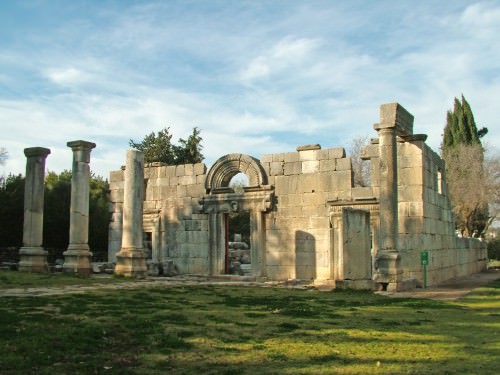
Kfar Bar'am Synagogue
THE ROLE OF THE ANCIENT SYNAGOGUE
Inscriptional and literary evidence suggests that judicial proceedings, archives, treasuries, prayers, public fasts, communal meals, and lodging for traveling Judeans were all associated with the ancient synagogue. The public reading and teaching of the Torah took precedence over all else by providing the liturgical activity that set the synagogue apart, but the synagogue was much more than a religious institution and must be considered as distinctly different from its predecessor, the Temple.
UNLIKE THE EXCLUSIVITY OF TEMPLE RITUAL, ANCIENT SYNAGOGUE PARTICIPANTS WERE INVOLVED IN THE PERFORMANCE AND CONDUCTING OF CEREMONIES, RECITING PRAYERS, AND READING FROM THE TORAH.
Following the destruction of the Second Temple and the rise of Rabbinic Judaism, a more democratic form of worship began to take root, as well as concepts such as urbanization and institutionalization, which spread throughout the Roman, and later Byzantine, Empire. With the end of the Second Temple period came the end of the practice of sacrifice, and so the reading of the Torah filled the void. As a result, the Ark of Scrolls and the Torah shrine developed, eventually emerging as the focal point of the synagogue, representing a symbol of survival and preservation. Nearly every ancient synagogue in the land of Israel yields traces and fragments of a Torah shrine, either in the form of a raised platform as a base for the aedicula, a niche, or an apse. This evidence demonstrates the significance of the Torah shrine as one of the few consistent features within the ancient synagogue. Yet the appearance of the Torah shrine was not the only emergent trait accompanying the rise of Rabbinic Judaism. Unlike the exclusivity of priestly-mediated ritual attributed to the Temple, the participants in the ancient synagogue were involved in the performance and conducting of ceremonies, reciting prayers, and reading from the Torah. A new participatory nature of worship was developing during this period, and it is preserved through the architectural remains.
As the rabbinic class rose in power, criteria that may be deemed "non-religious" began to fall under the control of the rabbis, and therefore, the "religious" domain. In terms of legal matters, Tannaitic cases may relate to settlements for divorce/widowhood, damages for public shaming, deeds dating on the Sabbath, and so on. Despite the fact that other venues were available for resolving legal matters, the rabbinic judges served as an alternate, and seemingly popular, venue.Generally, rabbinic legal activity revolved around property and family issues, which occasionally intersected with ritual law such as in Deut. 5-10 and halîsâ, a ceremony concerning the obligation of a man to marry his brother's childless widow. Quite simply, aside from the reading and studying of the Torah, the separation of religious and non-religious functions is not as clear as one may assume in terms of the activities performed in the ancient synagogue. Whether separate or not, both religious and non-religious activities attributed to the synagogue originated in response to communal requirements, differing in distribution throughout the ancient world with the exception of the study of the Torah, around which the synagogue's ultimate purpose revolved.
As a result of the Torah's dominance in synagogue performance, it seems only reasonable that it would become a popular motif with the rise of Jewish art in late antiquity, and in fact, the Torah Ark would become just that. Yet the Torah's dominance would be expressed by other means as well, such as with the development of the Torah shrine as the focal point and physical statement of Judean religious and historical lineage. Beyond the Torah shrine, however, the ancient synagogue would come to develop additional features and characteristics that reflected communal needs and practices, all of which are evident in archaeological remains.
THE FORM & STRUCTURE OF THE ANCIENT SYNAGOGUE
Unlike the Temple or the Tabernacle, a synagogue could be established anywhere, as it is not believed that the synagogue was ordained by Yahweh /God. Yet sources, such as the Sages, do suggest a level of holiness in the synagogue when stressing the importance of scripture, and the appearance of the Tabernacle in synagogal art may represent a “seal of approval” or sanctity as well. It is important to remember, however, that although the synagogue represented much more to the community than a place of worship or prayer, it was only deemed “holy” or “sacred” with the presence of the Torah.
As synagogues were not restricted to a specific location, and as no uniform design or floor plan of the ancient synagogue exists, the community was at liberty to build the structures in accordance to their own local requirements. They may be located on the seashore, along riverbanks, in the center of town, or in dwelling quarters. The only common feature to be found in terms of location is convenience for the community for both commercial and communal activities.
The synagogue should be understood as a physical mediator between the individual and the community at large. As a public space, the synagogue became a focal point in Judaism, much like the Temple pre-70 CE. As a structure, the ancient synagogue may have consisted of a single public building or a complex including rooms and courtyards, and the layout of each building varied. The evidence of extra rooms, as well as fountains, cisterns, and basins, demonstrates several characteristics of the local Judean community in which the building was established. Once again, local demands influenced the design and function of the synagogue within each individual community, and it is through the examination of the remains that particular communal requirements may be discerned. For instance, the presence of extra rooms suggests various possibilities. The first possibility indicates lodgings or hostel services in which the synagogue offered temporary accommodations for travellers, pilgrims, or synagogue officials. The appearance of extra rooms may also point toward the existence of a dining room, school, ritual baths (miqva'ot), or additional space for circumstances such as the New Moon or the Sabbath.
Without a universal floor plan, it is clear that each community valued and required different architectural or functional features, and the design of a synagogue was decided upon by the leaders of the community rather than according to an established synagogue standard. That being said, however, as the Torah shrine was located along the Jerusalem -oriented wall within each synagogue in antiquity, it is reasonable to suggest that a Judean travelling from Ostia to Ein Gedi would feel comfortable within the foreign synagogue, so far as the fundamental characteristic, namely the Torah, was concerned.
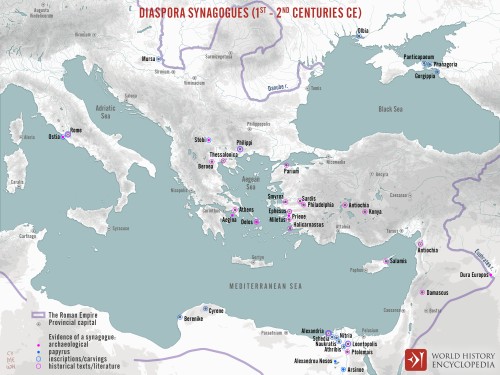
Map of Ancient Synagogues
THE ANCIENT SYNAGOGUE IN THE DIASPORA
Much attention has been placed on the synagogues of ancient Israel thus far, however, many of the same conclusions may be made in terms of the Diaspora synagogue. Individuals living within the Diaspora experienced a disconnection from the Temple in a period much earlier than 70 CE. As a result, accommodations and supplementary modes of worship developed for those who were unable to make the pilgrimage to the Temple. Unfortunately, the synagogues in Delos and Ostia are the only locations that can be archaeologically dated prior to the 2nd century CE; however, it is probable that synagogue architecture had not yet developed to a distinguishable level until that time. Considering that several Diaspora synagogues began as domestic structures, only later acquiring monumental characteristics, this theory is especially persuasive.
The function and style of the Diaspora synagogue were not unlike the synagogue of ancient Israel. Like their counterparts in Israel, Diaspora synagogues display some variation in terms of style and artistic content, yet a common and shared tradition appears to have influenced Judeans everywhere. There is little consistency in terms of location, yet this inconsistency is a trend that is shared by both synagogues in Israel and those in the Diaspora. The only quality that the locations share is the convenience they provided to the community, both commercial and communal. Aside from that, the location may represent the prominence and social acceptance of the local Jewish community, especially in the Diaspora. For instance, in a metropolitan city such as Alexandria, if a synagogue were discovered in the city center or along the central street, this would suggest a high level of acceptance by the general population for the Judean community. The prominence of the community would also be reflected in the existence of the synagogue, both in design and maintenance, as it would require great expense by the Judean community itself. Interestingly enough, inscriptions suggest that it was not only Judeans but also non-Judeans who made donations to the synagogue, perhaps in fulfillment of a vow. Under certain circumstances, some Christians even preferred to attend synagogue services rather than those of their own churches, as was the case in Antioch.
Location and the sheer existence of the synagogue aside, the orientation of the interior demonstrates a universal expression of loyalty, as each synagogue in antiquity was oriented towards Jerusalem. This suggests a preservation of the memory of the Temple as well as the history of the Judeans more generally. With each synagogue oriented towards Jerusalem, the community was reminded of the Temple as well as its destruction. The Jerusalem-oriented wall became a memorial that was repeated everywhere. It was along this wall that the Torah shrine was located, and despite the variations in style, including aedicula, niche, or apse form, the Torah shrine was the focal point of each synagogue, marking a change in significance for the institution following 70 CE by instilling a sacred or holy quality.
Aside from the presence of the Torah, there was one other feature that was widely spread in both Israel and Diaspora synagogues: purity concerns. Just as they - alongside sacrifice - dominated Temple Judaism, purity concerns persisted and were reflected in synagogue architecture. Whether they were incorporated into the design in the form of a fountain or basin, or the synagogue was merely located near a body of water, the necessity for water facilities was widely established in both Israel and the Diaspora. Despite the limited remains of miqva'ot near Diaspora synagogues, they were occasionally present in ancient Israel, perhaps as a lingering Temple tradition. Fountains, cisterns, or basins, on the other hand, were often located in the courtyard or entranceway of the Diaspora synagogue, suggesting a similar function to the miqva'ot, complementing the Mishnah and Tohorot, a post-70 CE construction expressing laws of purity, cleanliness, and uncleanliness. The existence of such concerns suggests that the synagogue represented more than a community center, while the inclusion of additional rooms and supportive inscriptional evidence indicates that the synagogue was more than a religious institution. The fact that this evidence is spread throughout the ancient Judean world, both within Israel and the Diaspora, demonstrates the expansive and diverse expressions of Judean identity in response to local influences and traditions.
CONCLUSION
Ultimately, the synagogue grew in popularity following the destruction of the Temple, allowing prayer and study to replace sacrificial practices as the means of serving God. Unlike the Temple, participation in the synagogue was open to the congregation members who were invited by the synagogue leaders to read scripture and even preach. Although the reading of the Torah became the prominent feature of the synagogue as is reflected through the universal inclusion of the Torah shrine in archaeological remains, the synagogue represented much more than a house of prayer. It was also an institution for teaching, lodging, communal meals, public fasts, judicial proceedings, public floggings, eulogies, nuptial matches, and so on. Essentially, the synagogue represented an ancient community centre, an institution that developed in various Judean communities throughout the ancient world in response to local social needs and preferences. As a result, the synagogue developed in the form of an assembly hall, and although architectural designs may vary, characteristic features such as the Torah shrine assist in identifying them within the archaeological record. Furthermore, the variety of architectural designs revealed that the existence of uniform worship did not require a uniform space.
LICENSE:
Article based on information obtained from these sources:with permission from the Website Ancient History Encyclopedia
Content is available under License Creative Commons: Attribution-NonCommercial-ShareAlike 3.0 Unported. CC-BY-NC-SA License